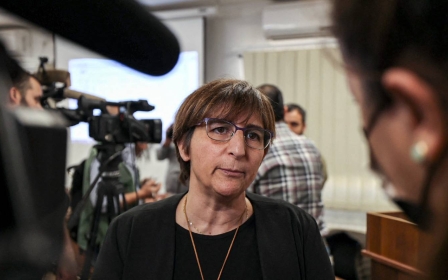Meet Blue Wolf, the app Israel uses to spy on Palestinians in the occupied West Bank

Cameras have long been an essential tool for Israel to monitor and watch Palestinians.
But these days, technology has advanced, with sophisticated facial recognition technology now used to screen Palestinians at military checkpoints.
But it's not just at checkpoints, according to a report in the Washington Post on Monday, which described a whole new level of surveillance in place across the West Bank called Blue Wolf.
Middle East Eye takes a look at this technology and what makes it different - more dystopian and more terrifying - when compared to what the Israeli military was already known to have in place.
What is Blue Wolf?
New MEE newsletter: Jerusalem Dispatch
Sign up to get the latest insights and analysis on Israel-Palestine, alongside Turkey Unpacked and other MEE newsletters
According to the Washington Post's report which was based on the accounts of six former Israeli soldiers, Blue Wolf is a smartphone technology that captures images of Palestinians in the occupied West Bank and then matches them with a database run by the Israeli military and intelligence.
Over the past two years, Israeli soldiers photographed Palestinians, including women, the elderly, and children - sometimes against their will - using Blue Wolf, with the number of photos taken reportedly running into the thousands.
To encourage uptake among soldiers, prizes were said to have been offered for the units that gathered the greatest number of photos of Palestinians to add to the database described by a former soldier as the army's "Facebook for Palestinians".
How does it work?
The Blue Wolf is believed to be part of a broader surveillance policy, initiated by the Israeli army in 2016, which deployed facial recognition technology, sensors, and cameras to monitor Palestinians in the occupied East Jerusalem and the West Bank.
What appears to be new is that, instead of taking photos from stationary cameras, Blue Wolf gives Israeli soldiers the ability to capture images from smartphones and then use an app to search a database.
The app then has a colour-coded system that indicates whether the person photographed should be arrested or allowed to pass, the soldiers told the Washington Post.
Where was Blue Wolf used?
Hebron, a city in the southern occupied West Bank, was reported to be the target of a mass, round-the-clock Israeli surveillance operation.
Hebron is divided into two areas, H1 under the complete administrative and security control of the Palestinian Authority (PA), and H2, administratively run by the PA but controlled by the Israeli military, which has the final say on who enters and who exits the area.
Some 40,000 Palestinians live in H2, adjacent to 800 Israeli settlers, monitored by 18 permanently staffed Israeli military checkpoints.
According to the Washington Post, along with soldiers collecting photos using Blue Wolf, surveillance cameras have been mounted every 300 feet in this area with some installed on the roofs of private houses, leaving residents feeling they are - and perhaps actually are - being watched relentlessly.
A former Israeli soldier who was involved in what is called the "Hebron Smart City" project told the Washington Post that the system in Hebron is "a total violation of privacy of an entire people".
What about White Wolf?
In addition to Blue Wolf, there is also White Wolf, a system reportedly set up in 2016 and used by Jewish settlers in the West Bank.
This technology allows a user to scan a Palestinian's identification card and check it against a database accessed by the Israeli army, Israeli intelligence, and settlement security departments.
This might be done, for example, before a Palestinian is allowed to enter a settlement to do construction work.
Israel has said that White Wolf is used to thwart any Palestinian violent attacks against settlers or army forces.
Where else are Palestinian surveilled?
The city of Hebron is not the only Palestinian area heavily watched by the Israeli forces and police. The old city of Jerusalem is another.
Though there are no confirmed reports that the Blue Wolf was used in Jerusalem, the ancient streets and alleys of Holy City are crowded with Israeli cameras.
According to the Who Profits? report published in 2018, Israel had installed almost 400 cameras in Jerusalem, which are connected to the internet and can turn 360 degrees.
At that time, there was an Israeli camera for every 100 people in Jerusalem, which has a population of 36,000 living in a one-kilometre square.
The surveillance system in Jerusalem was introduced at the start of the Second Intifada, part of a plan called Mabat 2000 - mabat meaning "gaze" in Hebrew - and also an acronym for technological and surveillance centre.
Mabat 2000 was put into action by the Israeli police, intelligence, and private companies, the report said.
It has a direct line of communication to 800 police officers and it could see 95 percent of the city as of 2018.
This article is available in French on Middle East Eye French edition.
Middle East Eye delivers independent and unrivalled coverage and analysis of the Middle East, North Africa and beyond. To learn more about republishing this content and the associated fees, please fill out this form. More about MEE can be found here.




